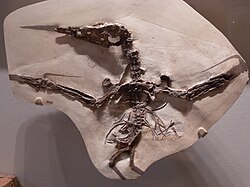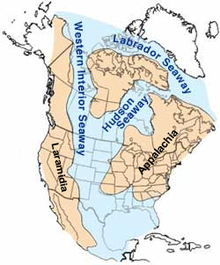Nyctosaurus
| Nyctosaurus | |
|---|---|

| |
| Fossil specimen (CM 11422) of Nyctosaurus gracilis in the Carnegie Museum of Natural History | |
| Scientific classification | |
| Domain: | Eukaryota |
| Kingdom: | Animalia |
| Phylum: | Chordata |
| Order: | †Pterosauria |
| Suborder: | †Pterodactyloidea |
| Family: | †Nyctosauridae |
| Genus: | †Nyctosaurus Marsh, 1876 |
| Type species | |
| †Nyctosaurus gracilis Marsh, 1876
| |
| Species | |
| |
| Synonyms | |
|
Genus synonymy
Synonyms of N. gracilis
Synonyms of N. nanus
| |
Nyctosaurus (meaning "night lizard" or "bat lizard") is a
Nyctosaurus was a mid-sized pterosaur that lived along the shores of the Niobrara Formation of the United States, which back then was within a large inland sea called the
Discovery and species
The first Nyctosaurus fossils were described in 1876 by

In 1953, Brazilian paleontologist Llewellyn Ivor Price named a partial humerus, DGM 238-R found in Brazil, N. lamegoi; the specific name honours the geologist Alberto Ribeiro Lamego. This species has an estimated wingspan of four metres; today, it is generally considered to be a form different from Nyctosaurus, but has not yet been assigned its own genus name.[2][7][8]
In 1972, a new skeleton, FHSM VP-2148, in 1962 discovered by
In 1978, Gregory Brown prepared the most complete Nyctosaurus skeleton currently known, UNSM 93000.[11]
In 1984, Robert Milton Schoch renamed Pteranodon nanus (Marsh 1881), "the dwarf", Nyctosaurus nanus.[6] The question of this species validity is currently pending further study.[2]
In the early 2000s, Kenneth Jenkins of Ellis, Kansas collected two specimens of Nyctosaurus, which were the first to demonstrate conclusively that not only was this species crested, but that the crest in mature specimens was very large and elaborate. The specimens were purchased by a private collector in Austin, Texas. Despite being in private hands rather than a museum collection, paleontologist Chris Bennett was able to study the specimens and gave them the manuscript reference numbers KJ1 and KJ2 (for Kenneth Jenkins). Bennett published a description of the specimens in 2003. Despite the unusual crests, the specimens were otherwise indistinguishable from other specimens of Nyctosaurus. However, the then-currently named species were extremely similar and Bennett declined to refer them to a specific one pending further study of the differences, or lack thereof, between species of Nyctosaurus.[2]
Description
Size and weight

Nyctosaurus was similar in anatomy to its close relative and contemporary, Pteranodon. It had relatively long wings, similar in shape to modern seabirds. However, it was much smaller overall than Pteranodon, with an adult wingspan of little over 2 meters (6.6 ft).[2] Some wingspan estimates by German paleontologist Peter Wellnhofer in 1991 however, reached a total of about 2.9 meters (9.5 ft), and the dubious species "N." lamegoi had a wingspan estimate of around 4 meters (13 ft) according to Price back in 1953.[12] It is estimated that N. gracillis was about 37.6 centimeters (1.23 ft) long and weighed 1.86 kilograms (4.1 lb).[13]
Skull and beak
Some skull specimens preserve a distinctively large crest, at least 55 centimeters (1.80 ft) tall in the older adults, and was relatively gigantic compared to the rest of the body, while also being over three times the length of the head. The crest is composed of two long, grooved spars, one pointed upward and the other backward, arising from a common base projecting up and back from the back of the skull. The two spars were nearly equal in length, and both were nearly as long or longer than the total length of the body. The upward-pointing crest spar was at least 42 centimeters (1.38 ft) long and the backward-pointing spar was at least 32 centimeters (1.05 ft) long.[2]
The jaws of Nyctosaurus were long and extremely pointed. The jaw tips were thin and needle sharp, and are often broken off in fossil specimens, giving the appearance that one jaw is longer than the other, though in life they were probably equal in length.[2]
Wings

Nyctosaurus had wings very similar in built to those of its relative Pteranodon, which have a high aspect ratio and low wing loadings. The wing structure generally resembles that of the modern-day albatross, and therefore also flew like it. Unlike the related Pteranodon however, Nyctosaurus was much smaller in size, and had a relatively shorter wingspan, though still large compared to earlier pterosaurs.[12][2]
Forelimbs
Like the closely related Pteranodon, Nyctosaurus also had relatively long forelimbs compared to other earlier genera. Most of the tendons of the upper arm and forearm were mineralized within, this is a unique feature only seen in nyctosaurids, another of which was the related
Nyctosaurus had unusually elongated
Studies on Nyctosaurus anatomy have concluded that the first, second and third metacarpals have lost contact with the
Hindlimbs
Contrary to its elongated forelimbs, Nyctosaurus had proportionally short hindlimbs compared to the overall body size. Analyses show that Nyctosaurus had the shortest hindlimbs of any pterosaur genera, in terms of hindlimb-to-body ratio, which was only about 16 percent the size of its wing.[14]
Classification

Below is a cladogram following Brian Andres and Timothy Myers in 2013, showing the phylogenetic placement of this genus within the clade Pteranodontia. Two species of Nyctosaurus (N. gracilis and "N." lamegoi) were included in the analysis, and were placed within the family Nyctosauridae, sister taxa to Muzquizopteryx.[15]
| Pteranodontia |
| |||||||||||||||||||||||||||||||||||||||||||||||||||||||||||||||||||||||||||||||||||||||||||||
In 2018, a topology by Nicholas Longrich and colleagues had made the clade Pteranodontoidea the more inclusive group, while Pteranodontia was restricted to only pteranodontids and nyctosaurids. In this analysis, three species of Nyctosaurus were included: N. lamegoi, N. nanus and N. gracilis; all three of which were placed as derived members of the Nyctosauridae.[16][9]
| Pteranodontoidea |
| ||||||||||||||||||||||||||||||||||||||||||||||||||||||||||||||||||||||||||||||
Paleobiology
Life history

Nyctosaurus, like its relative Pteranodon, appears to have grown very rapidly after hatching. Fully adult specimens are no larger than some immature specimens such as P 25026 (pictured below), indicating that Nyctosaurus went from hatching to adult size (with wingspans of 2 meters (6.6 ft) or more) in under a year. Some sub-adult specimens have been preserved with their skulls in nearly pristine condition, and lack any trace of a head crest, indicating that the distinctively large crest only began to develop after the first year of life. The crest may have continued to grow more elaborate as the animal aged, though no studies have examined the age of the fully adult, large-crested specimens. These individuals may have been 5 or even 10 years old at the time of their deaths.[2]
Crest function

Only five relatively complete Nyctosaurus skulls have been found. Of those, one is juvenile and does not possess a crest (specimen FMNH P 25026), and two are more mature and may show signs of having had a crest but are too badly crushed to say for sure (FHSM 2148 and CM 11422). Two specimens (KJ1 and KJ2) described in 2003, however, preserved an enormous double-pronged crest.[2]
A few scientists had initially hypothesized that this crest, which resembles an enormous
Wing loading and speed
Researchers Sankar Chatterjee and R.J. Templin used estimates based on complete Nyctosaurus specimens to determine weight and total wing area, and to calculate its total wing loading. They also estimated its total available flight power based on estimated musculature. Using these calculations, they estimated the cruising speed of Nyctosaurus gracilis as 9.6 meters/second (34.5 kilometers/hour or 21.4 miles/hour).[13]
Paleoecology

All known Nyctosaurus fossils come from the Smoky Hill Chalk of
The ecosystem preserved in this zone was unique in its abundance of vertebrate life. Nyctosaurus shared the sky with the bird
See also
References
- ISBN 978-1-78620-317-5.
- ^ S2CID 129438441..
- ^ S2CID 129700882.
- ^ Marsh, O.C. (1876a). "Notice of a new sub-order of Pterosauria." American Journal of Science, 11(3): 507–509.
- ^ Marsh, O.C. (1876b). "Principal characters of American pterodactyls." American Journal of Science, 12: 479–480.
- ^ a b Marsh, O.C. (1881). "Note on American pterodactyls." American Journal of Science, 21: 342–343.
- ^ Price, Llewellyn Ivor (1953). "A presença de Pterosauria no Cretáceo Superior do Estado da Paraíba". Notas Preliminares e Estudos, Divisão de Geologia e Mineralogia, Brasil (71): 1–10.
- .
- ^ PMID 29534059.
- ^ Eberhard Frey, Ross A. Elgin, Wolfgang Stinnesbeck, José Manuel Padilla-Gutiérrez, Christina Ifrim, Samuel Giersch, and Arturo H. González-González, 2012, "A new specimen of nyctosaurid pterosaur, cf. Muzquizopteryx sp. from the Late Cretaceous of northeast Mexico." Revista Mexicana de Ciencias Geológicas 29(1): 131–139
- ^ Brown GW (1978) Preliminary report on an articulated specimen of Pteranodon (Nyctosaurus) gracilis. Proceedings of the Nebraska Academy of Science 88: 39.
- ^ a b Witton 2013, p. 177.
- ^ ISBN 978-0-8137-2376-1
- ^ a b c d Witton 2013, p. 179.
- S2CID 84617119.
- PMID 24768054.
- ^
- ^ K. Carpenter, D. W. Dilkes, and D. B. Weishampel. 1995. The dinosaurs of the Niobrara Chalk Formation (Upper Cretaceous, Kansas). Journal of Vertebrate Paleontology 15(2):275–297
Further reading
- Witton, Mark (2013). Pterosaurs: Natural History, Evolution, Anatomy. Princeton University Press. ISBN 978-0-691-15061-1.
External links
- Nyctosauridae (scroll down) in The Pterosaur Database
